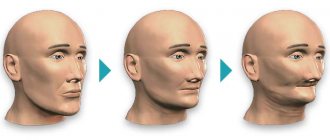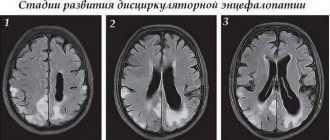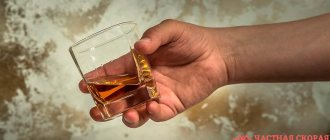Statistics show that more than half of the deaths of Russians under 54 years of age had diseases resulting from alcohol abuse. Excessive regular consumption of strong and low-alcohol drinks leads to dire consequences.
- What is alcohol intoxication
- Types of alcohol intoxication
- Stages of alcohol intoxication
- Stage 1 of intoxication: mild degree
- Stage 2 of intoxication: average degree
- Stage 3 of intoxication: severe
- How is severe intoxication determined?
- How does a person behave when intoxicated?
- Signs of alcohol intoxication
- External signs of a drunk person
- Person under the influence of alcohol
- Consciousness during alcohol intoxication
- Sclera during intoxication
- Diagnosis of alcohol intoxication
- State after alcohol intoxication
- Help with alcohol intoxication at the AlkoZdrav clinic
Types of alcohol intoxication
Drunkenness can be divided into simple and modified simple. In the second case, a person may behave inappropriately, paranoid tendencies or hallucinations may arise. It is worth noting that the degree of intoxication depends not only on the amount of alcohol, but also on the speed of its consumption. For example, 200 ml of pure alcohol drunk over 4 hours will lead to a drunken state. In 1 hour it will cause severe poisoning of the body.
Still have questions? Call us!
8
Free consultation and appointment
Stages of alcohol intoxication
The state of intoxication is measured in ppm. This is the number of alcohol in milliliters per 1 liter of blood. An ethanol content in the blood of up to 1.5 units is considered mild, and up to 2.5 is considered moderate. The number of ppm in the blood up to 5 is a severe degree of intoxication. More than 6 is a lethal dose.
Stage 1 of intoxication: mild degree
Mild intoxication makes itself felt by the following signs:
- All problems fade into the background, a person becomes sociable (sometimes excessively), cheerful, tightness and embarrassment disappear.
- The skin on the face turns pink due to dilation of the capillaries.
- The pulse quickens.
- A pleasant state of relaxation and tranquility.
- Slowing down the reaction rate.
It is precisely because of this state of liberation that many alcoholics begin to drink. This is especially true for people who are quiet by nature and find it difficult to meet people and communicate. Increasingly regular consumption of alcoholic beverages leads to addiction.
Stage 2 of intoxication: average degree
The nature of intoxication is quickly changing - just a minute ago the person communicated and loved everyone around him, but now he has become angry and cheeky. This means that the ppm level in the blood has increased to the average stage. You may notice incoherent speech, aggressiveness and rudeness, and loss of coordination. Even calm and kind people in this state can begin to provoke conflicts out of nowhere.
Stage 3 of intoxication: severe
An increase in the amount of alcohol, if not stopped in time, leads to the third stage. Severe alcohol intoxication can become dangerous not only for the drinker, but also for those around him. The person does not understand at all what is happening around him, he is not able to utter a word, coordination is completely impaired. Oddly enough, at this moment the level of libido increases sharply. In this state, many crimes are committed that people do not even remember when sober.
Alcohol breakdown products are eliminated from the body within approximately 24 hours. In this case, the breath is cleansed first, then the blood, and lastly the urine. For the first two stages, if we are not talking about an inadequate mental state, no medical intervention is required - a person just needs to sleep, drink plenty of water and eat a hearty meal.
Average degree of alcohol intoxication
3. Dysthymic phase
When healthy individuals consume individually different doses of alcoholic beverages (on average, about 300 ml of vodka, cognac or 1000 ml of wine) and achieve ethanol concentration in the blood in the range from 1.5 to 2.0 0/00 as the depth of intoxication increases there is a transition (transformation) of a hypomanic state into a dysphoric one.
The course of this phase largely depends on the personality of the drunk, because during this phase the so-called “exacerbation” and “exposure” of his character traits (features) are characteristic:
- people who are good-natured and cheerful in nature become maximally euphoric and goofy (they dance, sing, laugh, declare their love to everyone);
- people prone to a melancholy sad mood become tearful, they “admit their guilt,” ask everyone for forgiveness, cry, and beat themselves up;
- People who are rude in character can be tough and quite aggressive when intoxicated. Their behavior shows tactlessness, irritability, impulsiveness, and suspicion. Previous failures and grievances are updated. Inappropriate actions and torts are often committed.
There is a progressive decrease in the clarity of perception of the environment, a violation of the integrity of thinking. The associative process changes from superficial to grossly disordered, characteristic perseverations. It is difficult to attract active attention, often after numerous repetitions of questions.
Severe speech disturbances appear in the form of slowing down the pace, monotony, loss of rhythm, dysarthria, inarticulateness, slurred or scanned language, and distortion of words. Intoxicated people talk to themselves, conduct dialogues with a non-existent interlocutor, shout out individual words, often swear words. Productive verbal contact with such persons is difficult or impossible. At the same time, the behavior of a drunk changes and becomes uncontrollable by volitional efforts.
Thanks to this, cynical statements, undisguised sexuality, loss of modesty, and open fulfillment of physiological needs appear. In this state, the instinct of self-preservation is suppressed, situations dangerous to health and life are ignored. First, orientation of all types decreases and then becomes lost.
Complications of the memory activation process are noted. Impaired consciousness in such cases is similar to those in mild stupor. After sobering up, the events of the period of intoxication, as a rule, are fully recalled.
Up
4. Atactic phase
The most characteristic of this phase (degree) of intoxication are pronounced (noticeable to others) functional disorders of motor skills and coordination of movements - Ataxia alcoholica, caused by the toxic effects of ethanol on the neurophysiological mechanisms of the central nervous system, including the vestibulo-cerebellar.
The ability to perform even familiar everyday household skills is lost (for example, fastening buttons, lacing shoes, etc.). Handwriting changes. Movements become sweeping, numerous, unnecessary, inadequate, with loss of situational appropriateness (often reaching the level of psychomotor agitation). The gait is shaky and unsteady. A person who is in an average degree of intoxication often gets caught during a procession, may fall, but gets up and continues to walk on his own.
The typical appearance is: clothes are soiled, unkempt, disheveled. The face is puffy, hyperemic (but may also be pale), the sclera is damaged. Sometimes drunk people begin to sneeze frequently, experience extreme thirst, nausea, and vomiting. A pronounced odor of alcohol from the mouth is detected.
Other signs of the ataxic phase of intoxication include: instability in the Romberg position, tachycardia up to 100 - 110 beats per minute, tachypnea. Tendon reflexes are slightly reduced, and nystagmoid twitching of the eyeballs appears. After a test of scrolling the subject in a chair (5 times for 10 s), the nystagmus lasts 14 - 17 seconds. Muscle strength is significantly weakened, pain sensitivity is dull. Possible diplopia. The next day after atactic intoxication, a post-intoxication state is observed (weakness, weakness, thirst, headache, nausea, possible vomiting, aversion to alcoholic beverages).
Up
How does a person behave when intoxicated?
A person under the influence of alcohol can behave in completely different ways. Some people become aggressive and picky, others may start crying and complaining. Both men and women experience increased sexual desire, which often leads to casual sex without contraception. There are also those who simply fall asleep when drunk.
Separately, it is worth dwelling on cases of mental inadequacy. If a person starts getting into a fight, running with a knife after “monsters”, “dragons”, etc., it is best to seek help from doctors. Under no circumstances should you start a showdown or scold a drunk, because he is not aware of his actions.
Mild degree of simple alcohol intoxication
Subclinical phase
This includes cases of a dissociated clinical picture: the presence of alcohol in the blood above the level of endogenous ethanol (0.05 - 0.20/00), but not more than 0.50/00. In such cases, as a rule, no visible psychopathological, somatoneurological and intoxication symptoms are observed and criticality towards one’s behavior is completely preserved. In such cases, it is usually not possible to smell alcohol in the exhaled air. At the same time, the effect of even minimal concentrations of alcohol on the central nervous system is confirmed by biochemical, pathophysiological and psychological research methods.
Alcohol disrupts intellectual and mental functions - it has been experimentally proven that 10-15 grams of pure alcohol interfere with the performance of psychological tests, impair understanding of instructions, and memorization. Intoxication is accompanied by a deterioration in the ability to count operations, a weakening of combinatorial associative processes, visual and auditory perceptions, and reaction speed.
In subjective sensations, some inadequate increase in mood, ease of contact with others, increased appetite and a feeling of warmth in the epigastrium are noticeable, due to the presence of low concentrations of alcohol in liquid media and body tissues.
If such a level of alcohol in the blood is detected in the elimination phase, there are possible residual (vegetative, neurological, mental) signs of previous alcohol intoxication of a more severe degree, that is, one of the stages of sobering up. Biochemical and gas chromatographic tests for alcohol are positive. In such cases, the examination report must clearly indicate that the examination results indicate the presence of subclinical intoxication. It may be the result of taking a small dose of alcohol immediately before the examination (rarely encountered in expert practice), or it may be the residual effects of mild alcohol intoxication, which occurred shortly before the examination.
Up
2. Hypomanic phase
This state of alcohol intoxication develops after a practically healthy person takes small doses of alcoholic beverages: 50 - 150 ml of 400 vodka or other strong drink, 200 - 400 ml of 14 - 180 wine or 1 liter of 2 - 30 beer. Qualitative tests for alcohol are positive. When quantitatively determined in the blood, it is found to be 0.5 - 1.5 0/00.
The correlation between the clinical picture of mild alcohol intoxication and psychiatric terminology allows us to classify it as a hypomanic state, in which, as a result of the psychotropic effects of alcohol, changes in mental functions occur, so to speak, with a “+” sign (plus -symptoms). Mild ideomotor arousal is observed: elevated mood, increased gesticulation and motor activity (slight disinhibition), acceleration of associative processes, easier verbal contact with others. There is an illusory (towards a positive) perception of the outside world, a feeling of physical and mental comfort, self-satisfaction, an inadequate feeling of “intellectual uplift”, a surge of warmth, strength, vigor, increased efficiency, and sometimes a slight pleasant dizziness.
It is worth noting that with a special examination of such persons it turns out that the subjective feeling of improvement in mental functions is illusory, because in this case their qualitative characteristics will certainly decrease. For example, the impression of “relieving fatigue” is simply due to a dullness of sensations.
In this state, shyness, stiffness, tension disappear, anxious thoughts and worries are suppressed (Anxiolytic effect of alcohol). In this regard, a person in a state of intoxication in a good mood cannot refuse the requests of his interlocutor, becomes too nice, generous, promises a lot, is sociable, and easily makes acquaintances.
Affective instability is often noted - euphoria easily changes to anger, aggression, tearfulness. A feeling of sympathy easily turns into a feeling of antipathy and hostility.
Speech production intensifies in the form of verbosity, talkativeness (sometimes to the point of obsession), a tendency to praise, complacency, hyperbolism, and deceit appears. Speech remains clear, loud, meaningful, but somewhat accelerated. Topics of conversation change quickly and easily. Facial reactions are simplified, but very expressive. A slight overestimation of one’s strengths and capabilities at this stage is still quite easy to correct, a characteristic oversight, distractibility, but at the same time the orientation in place, time and one’s own personality is preserved.
Against this background, disinhibiting instincts (increased appetite, libido) and lower emotions. Tactile and pain sensations decrease, the threshold for perception of sound, visual (including color) stimuli increases. The hypomanic phase of intoxication also includes moderately expressed vegetative symptoms: hyperemia (less often paleness) of the facial skin, scleral swelling, shiny eyes, hypersalivation, tachycardia and increased breathing.
The smell of alcohol is felt in the exhaled air, but one should keep in mind the frequent attempts of subjects to neutralize the smell of alcohol with aromatic substances, deodorants, chewing gum or heavy smoking.
The most significant signs of this stage of intoxication are:
- deterioration in the clarity of reproduction of complex professional and everyday skills (reaction time to external stimuli may be reduced, but their quality deteriorates)
- violation of precise coordination of movements and corresponding tests (drawing on paper of elementary geometric figures, picking up a coin, a match from the floor, fastening small buttons, lacing shoes - the subjects do all this unclearly)
- when walking, the subjects drift slightly to the side; in the Romberg position and when squatting with their eyes closed, swaying is observed;
- pupils are normal size or slightly dilated.
It is characteristic that the psychopathological and behavioral components of mild alcohol intoxication, in contrast to vegetative ones, can vary depending on situational factors. Thus, during group consumption of alcoholic beverages, this degree of intoxication manifests itself in the majority of individuals in the same way, that is, “general gaiety.” As a result of the preservation of criticism and orientation of all types, the clinical hypomanic phases of alcohol intoxication in situations unsuitable for fun (for example, delivery by the police for examination) can be suppressed (“encapsulated”) or transformed by an effort of will. During the examination, instead of elevated mood in such cases, anxiety, restlessness, conflict, anger, and attempts to imitate a sober state are recorded. Temporary memory disturbances (palimpsest) do not occur with this degree of intoxication: memories of all events during the period of intoxication are preserved in full.
Up
Signs of alcohol intoxication
Signs of intoxication include:
- Change in facial expressions;
- overly active gestures and loud voice;
- staggering, lack of coordination;
- change in behavior, for example, a calm person suddenly became nervous and angry;
- in severe cases of intoxication, fecal and urinary incontinence is possible.
If a drunk has passed out completely, the pulse has become slower and uncontrollable bowel movements or urination have occurred, it is necessary to urgently call an ambulance. Alcohol coma can lead to a detailed outcome.
External signs of a drunk person
From a purely outward appearance, a drunk can be seen immediately.
Person under the influence of alcohol
A drunk person reveals himself primarily by changing his facial expression. This may be either too active facial expressions, or, conversely, complete detachment. The look with small doses of alcohol becomes “brilliant”; with an increase in the amount of alcohol, the pupils of the eyes may stop reacting to light.
The skin on the face first becomes pink, and with severe intoxication it turns pale. A blue tint and swelling indicate a disruption in the functioning of the heart and kidneys.
Consciousness during alcohol intoxication
As mentioned above, the consciousness of a drunk can be either scattered or completely disconnected. The most dangerous option is when a person cannot sleep and becomes aggressive.
Sclera during intoxication
If we are talking about severe alcohol intoxication, the sclera of the eyes acquire a yellowish tint. This indicates problems with the liver. Such medical clinical signs require medical intervention.
Field score:
Total score:
Patient age
Length of use
What he uses Has he previously undergone treatment Consent to treatment Concomitant diseases Employment
Waiting for values to be entered
Severe degree of alcohol intoxication
5. Adynamic phase
After drinking large doses of alcohol and reaching its concentration in the blood above 2.5 0/00 in the clinical picture of acute alcohol intoxication, increasing ones come to the fore: muscle hypotension, adynamia, disorders (stupefaction) of consciousness. The appearance of these symptoms is due to inhibition of the higher parts of the central nervous system. Motor activity in such persons sharply decreases, the gait is unstable, shaky, and stability in an upright position is gradually lost. Physical weakness increases. Being turned onto their backs, drunk people still try to return to their sides, on their stomachs, performing chaotic, helpless movements with their arms and legs. When they try to get up, they fall. The appearance is untidy, the clothes are dirty, there are bruises and bruises on the face and body. Language is grossly violated: drunken people persevere, muttering inarticulate fragments of words or phrases under their breath. Productive speech contact when examining such individuals is practically impossible. Gradually there is a deepening of violations of criticism and orientation of all kinds. There is apathy, indifference to the environment, to dangerous situations, uncomfortable postures, and there are practically no adequate facial reactions. Vomiting and diarrhea may occur.
The skin is pale, cold, damp. There is a strong odor of alcohol in the exhaled air and vomit. Cardiac activity weakens, heart sounds are muffled, and blood pressure decreases. The pulse is frequent, weak and tense. Breathing is shallow, rapid, and may be hoarse due to hypersalivation and accumulation of mucus in the nasopharynx. Due to relaxation of the sphincters, uncontrollable urination and defecation often occur. Neurological symptoms are detected: decreased or absent conjunctival pain reflexes, dilated pupils, weak reaction to light, spontaneous horizontal nystagmus, decreased tendon reflexes. The subject, being in the adynamic phase of alcoholic intoxication, looks drowsy outwardly and can spontaneously fall asleep in any place and in positions that are not physiological for sleep. During sleep, convulsions, urination, and bowel movements may develop. As a rule, it is possible to wake up a drunk person, but he immediately falls asleep again. Inhalation of ammonia vapor causes only a short-term sluggish protective reaction. Deep, heavy sleep is a mandatory clinical component of this phase (degree) of intoxication. After awakening, restoration of the memory of a period of severe intoxication occurs differently in different individuals: in some, memories are fragmentary, with gaps, others do not remember anything (complete amnesia), in others, events can be recalled completely. In persons who have undergone the adynamic phase of alcohol intoxication, post-intoxication symptoms are observed for several days: asthenia, hypo- or adynamia, autonomic disorders, dyssomnia, dysarthria, anorexia, dysphoria, irritability, etc.
Up
Anesthesia phase (alcoholic coma)
In a number of classifications of acute alcohol intoxication available in the literature, alcoholic coma is also included in severe alcohol intoxication. In our opinion, for expert and therapeutic practice, it is more appropriate to include in the previous (adynamic) phase of alcohol intoxication all cases of disorders of consciousness, with the exception of loss of consciousness (that is, an amental state or drug stupor - alcoholic coma). In the latter case, such persons, as is known, require emergency medical care for life-saving reasons in an intensive care unit or toxicology department, because in this condition paralysis of the central autonomic centers is possible.
The average concentration of alcohol in the blood that causes loss of consciousness (narcotic intoxication phase) ranges from 3 to 5 0/00, but coma can develop at less (2-2.5 0/00) or higher (5-6 0/00). 00) blood alcohol content. The symptoms of alcoholic coma are caused by the spread of extreme (toxic-alcoholic) inhibition throughout the entire cerebral cortex, subcortical and brainstem-diencephalic structures, the cerebellum and spinal cord. Only the vascular and respiratory centers, as well as the hypothalamic nuclei, which support metabolism, remain uninhibited.
Up
Degrees of alcoholic coma
Depending on the depth and dynamics of the toxic process, alcoholic coma is divided into 3 stages:
I degree (superficial coma with hyperreflexia)
A drunk person is in an unconscious state and does not react spontaneously to his surroundings. However, in response to strong stimuli (for example, when raising a cotton swab soaked in ammonia to the nose), a short-term motor reaction occurs with chaotic “defensive gestures” of the arms, legs, facial muscles, and dilation of the pupils. Tendon reflexes are increased, proprioceptive reflexes are preserved or increased, abdominal reflexes and mucosal reflexes are decreased, the swallowing reflex is preserved. Trismus of the masticatory muscles and fibrillary muscle twitching at the injection site develop. Babinski's symptom is determined.
A pronounced tendency to hypothermia and increased blood pressure. Breathing is shallow and rapid.
Up
II degree (superficial coma with hyporeflexia)
Fainting with deep depression of reflexes (tendon, corneal, pupillary, pharyngeal, etc.). Characteristic mydriasis, a barely noticeable reaction of the pupils to light.
Breathing is weakened, shallow, repeated vomiting, hypersalivation, bronchorrhea. Possible aspiration of mucus, vomit, broncholaryngospasm, spontaneous urination. A pronounced tendency to fall in blood pressure. Tachycardia 90-110 beats per minute.
Up
State after intoxication
After drinking alcohol, a person begins to feel symptoms of intoxication in the body:
- Nausea and vomiting.
- Hand tremors.
- Dry mouth, thirst.
- Aversion to alcohol.
- Completely inoperable.
- Chills.
- Headache.
- In severe cases, increased blood pressure and tachycardia.
As a rule, after drinking too much alcohol, it is enough to increase the amount of water, take vitamin C, eat a hearty meal, take a shower and sleep. If we are talking about severe cases (heart rhythm disturbances, vomiting does not stop, stomach pain), you may need the help of a narcologist. You also need to call a doctor if a person has been on a binge for more than 3 days - it will be almost impossible to stop on your own without cleansing the body.











